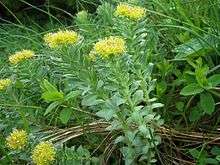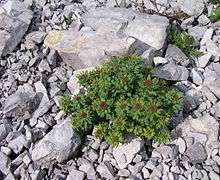Rhodiola rosea
| Rhodiola rosea | |
|---|---|
 | |
| Scientific classification | |
| Kingdom: | Plantae |
| Clade: | Angiosperms |
| Clade: | Eudicots |
| Order: | Saxifragales |
| Family: | Crassulaceae |
| Genus: | Rhodiola |
| Species: | R. rosea |
| Binomial name | |
| Rhodiola rosea | |
| Synonyms[1] | |
Rhodiola rosea (commonly golden root, rose root, roseroot,[2]:138 Aaron's rod, Arctic root, king's crown, lignum rhodium, orpin rose) is a perennial flowering plant in the family Crassulaceae.[3] It grows naturally in wild Arctic regions of Europe (including Britain), Asia, and North America, and can be propagated as a groundcover.[3] Although it has long been used in traditional medicine for several disorders, notably including treatment of anxiety and depression, there is little scientific evidence to verify any benefit.[4][5]
Description
Rhodiola rosea is from 5 to 40 centimetres (2.0 to 15.7 in) tall, fleshy, and has several stems growing from a short, scaly rootstock. Flowers have 4 sepals and 4 petals, yellow to greenish yellow in color sometimes tipped with red, about 1 to 3.5 millimetres (0.039 to 0.138 in) long, and blooming in summer. Several shoots growing from the same thick root may reach 5 to 35 centimetres (2.0 to 13.8 in) in height. R. rosea is dioecious – having separate female and male plants.


Taxonomy
Rhodiola rosea was first described by Pedanius Dioscorides in De Materia Medica.[4] Western North American plants formerly included in R. rosea are now treated as Rhodiola integrifolia and Rhodiola rhodantha.[6]
Chemical constituents
About 140 chemical compounds are in the subterranean portions of R. rosea.[7] Rhodiola roots contain phenols, rosavin, rosin, rosarin, organic acids, terpenoids, phenolic acids and their derivatives, flavonoids, anthraquinones, alkaloids, tyrosol, and salidroside.[8][9]
The chemical composition of the essential oil from R. rosea root growing in different countries varies. For example, rosavin, rosarin, and rosin at their highest concentration according to many tests can be found only in R. rosea of Russian origin; the main component of the essential oil from Rhodiola growing in Bulgaria are geraniol and myrtenol; in China the main components are geraniol and 1-octanol; and in India the main component is phenethyl alcohol. Cinnamyl alcohol was discovered only in the sample from Bulgaria.
Although rosavin, rosarin, rosin, and salidroside (and sometimes p-tyrosol, rhodioniside, rhodiolin, and rosiridin) are among suspected active ingredients of R. rosea, these compounds are mostly polyphenols. There is no evidence that these chemicals have any physiological effect in humans that could prevent or reduce risk of disease.[10] Although these phytochemicals are typically mentioned as specific to Rhodiola rosea extracts, rosea and other Rhodiola species contain many other constituent polyphenols, including proanthocyanidins, quercetin, gallic acid, chlorogenic acid and kaempferol.[11]
Distribution
Rhodiola rosea grows in cold regions of the world, including much of the Arctic, the mountains of Central Asia, scattered in eastern North America and mountainous parts of Europe.[3][5] It grows on sea cliffs and on mountains[2] at high altitude.[3]
Uses
Food
The leaves and shoots are eaten raw, having a bitter flavor, or cooked like spinach, and are sometimes added to salads.[3][12] An extract is sometimes added as a flavoring in vodkas.[13]
Research and regulation
Through 2012, human studies evaluating R. rosea did not have sufficient quality to determine whether it has properties affecting fatigue or any other condition.[5][14] The U.S. Food and Drug Administration (FDA) has issued warning letters to manufacturers of R. rosea dietary supplement products unapproved as new drugs, adulterated, misbranded and in federal violation for not having proof of safety or efficacy for the advertised conditions of alleviating Raynaud syndrome, altitude sickness, and depression.[15][16] R. rosea is also listed on the FDA's Poisonous Plant Database.[17]
Traditional medicine
In Russia and Scandinavia, R. rosea has been used for centuries to cope with the cold Siberian climate and stressful life.[18][19] It is also used to increase physical endurance and resistance to high-altitude sickness, but the scientific evidence for such benefits is weak. The plant has been used in traditional Chinese medicine,[20] where it is called hóng jǐng tiān.
A 2012 report by the European Medicines Agency on literature concerning the dried extract of R. rosea stated that "The published clinical trials exhibit considerable deficiencies in their quality. Therefore 'well-established use' cannot be accepted" and added: "The traditional use as an adaptogen 'for temporary relief of symptoms of stress such as fatigue and sensation of weakness' is appropriate for traditional herbal medicinal products. ... The long-standing use as well as the outcome of the clinical trials support the plausibility of the use of the mentioned herbal preparation in the proposed indication."[21]
References
- ↑ Reid V. Moran (2009), "Rhodiola rosea Linnaeus, Sp. Pl. 2: 1035. 1753", Flora of North America online, 8
- 1 2 Stace, C. A. (2010). New Flora of the British Isles (Third ed.). Cambridge, U.K.: Cambridge University Press. ISBN 9780521707725.
- 1 2 3 4 5 "Rhodiola rosea L." Plants for a Future. 2012. Retrieved 28 February 2017.
- 1 2 "Rhodiola rosea". Drugs.com. 13 August 2018. Retrieved 9 October 2018.
- 1 2 3 "Rhodiola". National Center for Complementary and Integrative Health, US National Institutes of Health. September 2016. Retrieved 28 February 2017.
- ↑ Moran, Reid V, in Flora of North America. volume 8. pages 164-167
- ↑ Panossian A, Wikman G (2010). "Rosenroot (Roseroot): Traditional Use, Chemical Composition, Pharmacology, and Clinical Efficacy". Phytomedicine. 17 (5–6): 481–493. doi:10.1016/j.phymed.2010.02.002.
- ↑ Evstavieva L.; Todorova M.; Antonova D.; Staneva J. (2010). "Chemical composition of the essential oils of Rhodiola rosea L. of three different origins". Pharmacogn Mag. 6 (24): 256–258.
- ↑ Mao, Y; Li, Y; Yao, N (2007). "Simultaneous determination of salidroside and tyrosol in extracts of Rhodiola L. By microwave assisted extraction and high-performance liquid chromatography". Journal of Pharmaceutical and Biomedical Analysis. 45 (3): 510–5. doi:10.1016/j.jpba.2007.05.031. PMID 17628386.
- ↑ Boudet AM (2007). "Evolution and current status of research in phenolic compounds". Phytochemistry. 68 (22–24): 2722–35. doi:10.1016/j.phytochem.2007.06.012. PMID 17643453.
- ↑ Yousef GG, Grace MH, Cheng DM, Belolipov IV, Raskin I, Lila MA (Nov 2006). "Comparative phytochemical characterization of three Rhodiola species". Phytochemistry. 67 (21): 2380–91. doi:10.1016/j.phytochem.2006.07.026. PMID 16956631.
- ↑ Saratikov A.S. (1974). Golden Root (Rhodiola Rosea) (2nd ed.). Publishing House of Tomsk University. p. 158.
- ↑ "Beluga - Noble Russian Vodka". www.vodka-beluga.com. Retrieved 2018-06-21.
- ↑ Ishaque, S; Shamseer, L; Bukutu, C; Vohra, S (2012). "Rhodiola rosea for physical and mental fatigue: A systematic review". BMC Complementary and Alternative Medicine. 12: 70. doi:10.1186/1472-6882-12-70. PMC 3541197. PMID 22643043.
- ↑ Mitchell, LaTonya M (2 December 2015). "(Example, one of several) Warning letter: Nature's Health, LLC". Inspections, Compliance, Enforcement, and Criminal Investigations, US Food and Drug Administration. Retrieved 28 February 2017.
- ↑ Emma R. Singleton (18 June 2013). "Warning letter: Herbs of Light, Inc". Inspections, Compliance, Enforcement, and Criminal Investigations, US Food and Drug Administration. Retrieved 28 February 2017.
- ↑ "FDA Poisonous Plant Database". US Food and Drug Administration. 2017.
- ↑ Azizov, AP; Seĭfulla, RD (May–Jun 1998). "[The effect of elton, leveton, fitoton and adapton on the work capacity of experimental animals]". Eksperimental'naia i klinicheskaia farmakologiia. 61 (3): 61–3. PMID 9690082.
- ↑ Darbinyan, V; Kteyan, A; Panossian, A; Gabrielian, E; Wikman, G; Wagner, H (Oct 2000). "Rhodiola rosea in stress induced fatigue--a double blind cross-over study of a standardized extract SHR-5 with a repeated low-dose regimen on the mental performance of healthy physicians during night duty". Phytomedicine. 7 (5): 365–71. doi:10.1016/S0944-7113(00)80055-0. PMID 11081987.
- ↑ Chevallier, Andrew (2016). Encyclopedia of Herbal Medicine. DK/Penguin Random House. p. 127.
- ↑ "Assessment report on Rhodiola rosea L., rhizoma et radix" (PDF). European Medicines Agency. 27 March 2012. Retrieved 30 May 2017.
External links
